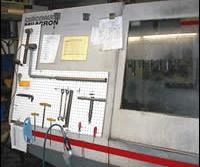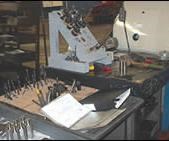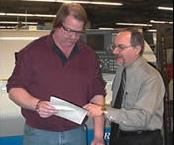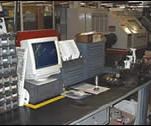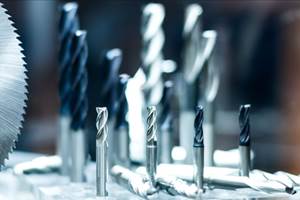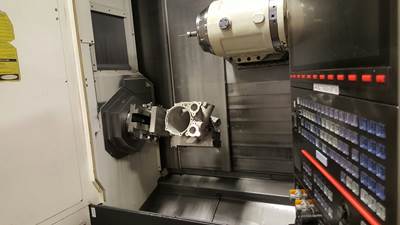Setup Reduction Is Central to Lean Manufacturing
This shop cut average setup time nearly in half. Now small batches can move quickly through the production process, making the company more responsive to customer needs than ever before.
Share




Crushing chest pains. Shortness of breath. Dizziness. Nausea. We all know the classic warning signs of a heart attack. Most of us also know that obesity, high cholesterol and inactivity signal an increased risk of heart disease. It's better to follow the doctor's advice about lifestyle changes before a frantic call to 911 is necessary.
Manufacturing companies often find themselves in situations that parallel those of the heart-conscious individual. Some companies are hit by crises that clearly threaten their survival. A big customer takes work overseas or demands a huge price cut, for example. Other companies take steps to avoid a crisis, adopting measures to keep them viable and competitive.
Richards Industries in Cincinnati, Ohio, is wisely following this second course. The company manufactures specialty valves for a variety of industries, including biotech, pharmaceutical, chemical, petroleum and power generation. Several years ago, the company recognized the symptoms of its own "less-than-optimal lifestyle." Among them were long lead times, excessive work in process, missed delivery dates, lost sales and outages in finished product inventory.
In response, the company adopted lean manufacturing, a multipronged approach to systematically reducing waste in all aspects of its shopfloor operations. Just as individuals have turned their health around by going on a diet, quitting smoking or starting an exercise program, Richards Industries has taken some clear steps to protect and improve its health as a manufacturer.
The company rearranged its machine tools into cells. It moved part inspection to the shop floor and eliminated a major bottleneck in the inspection lab. Other bottlenecks, such as long dry times in the paint department, were also eliminated. Work areas were reorganized to make them more orderly and less cluttered.
These changes have helped the company shorten lead times, slash batch sizes and reduce work in process. These changes have also focused the company's attention on another important aspect of lean manufacturing—setup reduction. Reducing setup time is essential to reducing lead times, batch sizes and work-in-process levels. So for the last 2 years, the company has worked hard to adopt quick changeover procedures in its machining operations. The results have been impressive.
In January 2002, average setup time was 50 minutes. Today, the average is 27 minutes, almost 50 percent faster. The goal is 20 minutes, an average the shop expects to hit by the end of this year.
Today, the typical shop order calls for 20 to 30 pieces to be processed in a batch. Two years ago, 200 pieces was the norm. Instead of multiple pallets moving from machine to machine, now there is usually only one. Small batches can now flow much more quickly, cutting lead times from weeks to days. With shorter lead times, fewer finished items need to be stocked to fill customer orders. The capital tied up in work in process and in finished goods inventory can be invested elsewhere.
According to Doug Parham, vice president of operations and the current "champion" of Richards Industries' lean initiatives, the shop has almost finished its first round of setup reduction projects. What sets this effort apart is that the company has exercised extraordinary discipline and persistence in this pursuit, striving to maintain a sense of urgency despite the lack of a glaring emergency. In that regard, the effort has been outstanding.
In a nutshell, the shop is doing exactly what the doctor ordered.
Wisdom in Maturity
Richards Industries, a privately held company, has been manufacturing specialty valves since 1947. It has four lines of distinctly different valves and related products. The three main valve lines are Jordan Valve (valves and regulators), Marwin Valve (ball valves) and Hex Valve (instrument manifolds, orifice block valves, gauge valves, needle valves and block and bleed valves). The Bestobell line of steam traps completes the range. All of these products can be ordered as standard items, but the company has made a specialty of custom engineering variations for critical or unusual applications.
For the most part, the machining processes used to produce these valves are unremarkable. The machine shop is populated mainly with older CNC lathes and mills, about 30 machines in all. However, the shop has kept up with advances in cutting tools, coolants and programming techniques.
Gilbert Richards, the company owner, has consistently taken a keen interest in the company's performance and in the well-being of its employees. About 3 years ago, he began studying lean manufacturing as a promising concept for improving the company's overall performance and profitability.
He and his top managers recognized some key facts about the company's business. In a mature industry, the company would have to compete on price and responsiveness to customers. Sales were not likely to expand in response to new product technology. Likewise, cycle times on the shop floor were not likely to yield significant improvements. To prosper, if not to grow, the company needed to get lean.
The Road to Lean Manufacturing
In 2001, Richards Industries invited productivity consultants from TechSolve, also a Cincinnati-based firm, to audit the shop's operations and recommend a path to lean manufacturing. Initial studies of work flow revealed a situation common in many companies. Bottlenecks in the machining area were causing skids of workpieces to accumulate in queues, especially at certain machines. Because machine tools were grouped by type, workpieces often traveled long distances, moving back and forth between departments. All inspection was done in a centralized quality control lab, so parts routinely encountered long delays before moving to the next process.
Among the recommendations was a plan to group the machine tools into "product manufacturing areas." Because the four main valve product lines are so distinct in design and function, they have no parts in common, sharing only certain raw materials such as barstock. Therefore, it made sense to move all of the machines devoted to machining components for each line into separate cells. Each cell would function as a mini job shop capable of producing all of the machined parts required to complete a certain valve product. Raw material entering each cell would stay within that cell until it is ready to move to the assembly area, paint station or finished parts storage.
As this plan was being studied, a series of general training sessions on lean manufacturing was also launched for company employees.
In January 2002, Mr. Parham came on board to lead the company's implementation of lean manufacturing. Mr. Parham had been employed at another local company, where he had spearheaded several lean manufacturing initiatives.
"It was clear that excessive work in process and finished inventory were major problems," Mr. Parham recalls. "When I arrived, I found a company with solid product lines, a stable and dedicated workforce, a management team committed to improvement—and a factory crowded with work in process." Just as the problems were clear, Mr. Parham believed that the solution was equally clear: The company had to reduce its setup time.
The Part Changeover Challenge
Mr. Parham challenged the shop to reduce setup time from 50 minutes to 20. At first, the challenge was greeted with some scoffing and skepticism, but also with a willingness to try. Mr. Parham's past training and prior experience with setup reduction’s benefits gave him confidence that this goal was not unrealistic. "I knew that other shops have been able to reduce setup time by 50 to 75 percent, usually without bringing in new technology. I was sure we could do it here as well," he says.
The first step was to go ahead with the plans for regrouping the machine tools into cells. In this arrangement, machines could share common setup areas, tool storage and fixturing items. This set the stage for setup reduction.
Mr. Parham also made sure that everyone understood how setup was defined in the context of lean manufacturing. Setup is the time between the last good piece of the current run and the first good piece of the next run.
It's not about cycle time—how fast the machine completes a part. Setup covers more than loading and unloading workpieces. Setup covers more than fixturing and clamping strategies.
The next step was to identify the worst bottlenecks—the machines with the longest setup times. These bottlenecks offered the opportunity for the biggest initial improvements. Dealing with these "monuments" became the shop's first priority.
After that, the plan was to follow a series of "setup reduction events" as practiced by most lean manufacturing experts. Each event follows four steps:
- Document the current changeover.
- Determine what setup steps can be done while the machine is still running.
- Streamline setup steps that must be done while the machine is not running.
- Put the basics in place for workplace organization and visual control.
The company set out to apply this process systematically, one machine at a time, starting with those machines that had the longest setups. Each "setup reduction event" took about a week. The first was held in February 2002.
"One of the first things we learned is that we needed to apply 5S throughout the shop right away," says Mr. Parham, referring to the workplace organization system based on the principles of sort, shine, simplify, standardize and sustain. 5S is designed to create an efficient workplace in which clutter, disorder and extra steps are brought under control.
After 3 months of applying 5S, each cell was noticeably less cluttered and more orderly. Activities were easier to observe. Work flow was easier to monitor. 5S made subsequent setup reduction events more effective.
How to Analyze Part Setups
Each setup reduction event begins by videotaping one or two complete setups, recording every action the operator performs in a part changeover. A time-marker on the video camera allows reviewers to construct a detailed sequence of setup activities, which is recorded in a computerized spreadsheet. How long each step takes is derived from the time-marker readings.
Although creating this "element breakdown" spreadsheet can be tedious, Mr. Parham insists that it is worth the effort. "It allows an objective analysis of existing setup procedures," he says. It also takes some of the emotion out of the setup reduction event. "It has to be clear that this is not about finding fault, but about turning good processes into better ones."
After the videotaping and element breakdown are complete, a team is put together to conduct a brainstorming session. Its purpose is to come up with all of the ways setup can be reduced and to sort out the best of these ideas. The team includes the operator from each shift, a manufacturing engineer and a CNC programmer. Representatives from other departments are designated to be on standby if their input is needed. These representatives include someone from design engineering, purchasing, production planning and inventory control. If called, these individuals are ready to join the meeting to offer suggestions or comments from their perspectives.
Structuring the team is important, Mr. Parham says. "You want to exclude anyone who hampers the free flow of ideas. Someone with an authoritarian or judgmental attitude spoils the atmosphere and makes it difficult for others to freely speak their minds and share ideas," he says. "It has to be understood that every idea will be evaluated fairly and considered solely on its own merits. No idea is too crazy to consider."
Brainstorming sessions follow a standard agenda shared with the group before the session starts. The five steps are:
- Review the video and element breakdown.
- Brainstorm and discuss ideas to improve.
- List action items Assign responsibilities.
- Schedule and implement the plan.
When reviewing the element breakdown, the team immediately determines which setup elements are external and which are internal. External steps, those that can be done while the machine is running, can be pulled out of setup right away, but procedures must be developed to ensure that these steps are completed before a current run is finished. External steps include getting parts, fixtures, gauges and cutting tools ready for the next run.
Internal steps, those that must take place when the machine is not running, must be streamlined. This is usually a matter of organizing the workspace. Having all tools ready and within reach is an example.
"The challenge is to do this first round of setup events without spending any money," Mr. Parham says. (This does not count any investments for 5S applications, such as constructing shadow boards, new shelving, storage units and so on.) Trying to hold a zero budget encourages the team to concentrate on the root causes of waste rather than treating its symptoms. Extra steps, waiting time, miscommunication and other causes of waste can usually be resolved without incurring costs.
Although setup reduction events focus on one machine or one changeover requirement, many of the suggestions could be implemented elsewhere at the same time. For example, one of the early events uncovered the fact that operators were not saving the programs that they created and debugged at the machine tool. This habit stemmed partly from operator preferences for certain programming techniques. Operators were routinely recreating programs and debugging them each time. Now, all of these programs are archived in memory at the machine controller, and they are also saved in appropriate directories on the file server of the shop's computer network.
Another typical outcome of an event was determining what consumable tooling items could be stored at each machine tool or workstation. As this and other point-of-use storage opportunities were discovered, the shop eventually closed its centralized toolroom and cleared the space for other uses.
On the last day of an event, the team reaches a consensus on what actions to take, who is responsible for each action and when the actions are to be completed. The group also decides when to reconvene to review progress and make modifications to the plan.
The Benefits of Setup Reduction as Continuous Improvement
In February 2004, two more setup reduction events took place. "We were actually revisiting machines where changeover times were still higher than we expected them to be," Mr. Parham explains.
He is quick to add that setup reduction is not something you do and then move on. The shop plans to repeat the series of setup reduction events as it strives to reduce changeover time even further. There is always room for improvement.
The second round of events will follow the same procedures that were used in the first. Both internal and external elements will be scrutinized, although internal elements, the ones that must take place while the machine is not running, are likely to get more attention. "That's when the clock is ticking, and every second saved ultimately reduces lead times," Mr. Parham says.
This is also the point to consider capital investments to streamline changeover procedures, he adds. A shop might consider adding pallet changers to VMCs, for example. Automation, such as automated gantry loaders for lathes, may be the answer in other cases. The return on such investments, however, will be clear because the effect on lead times can be easily demonstrated and documented.
Mr. Parham also says that the second round of setup events is a prelude to reviewing machine capability. In other words, the shop will study cycle times to see where productivity gains might be found. At this point, saving a few seconds here and there makes a difference, unlike situations in which shorter cycle times only add to longer queues at the next machine.
Ideally, the shop wants to reach the point at which quick changeover allows single-piece part flow. "Eventually, we want to link the release of each shop order to an incoming customer order and produce it at the same cost and lead time, even if the order produces a lot size of one," Mr. Parham says.
Just as the right diet and proper exercise are part of a healthy lifestyle and not a short-term treatment plan, lean manufacturing is a "lifestyle," too. Sustaining the effort is at the essence of the concept.
Lean manufacturing implies that a shop never stops working on setup time reduction. Mr. Parham believes that this is the most important lesson that Richards Industries has learned. There's no end in sight. But there's no end in sight to the company's ability to compete in its chosen niche, either. And that's what lean manufacturing is all about.
Related Content
Building Machines and Apprenticeships In-House: 5-Axis Live
Universal machines were the main draw of Grob’s 5-Axis Live — though the company’s apprenticeship and support proved equally impressive.
Read MoreAddressing the Manufacturing Labor Shortage Needs to Start Here
Student-run businesses focused on technical training for the trades are taking root across the U.S. Can we — should we — leverage their regional successes into a nationwide platform?
Read MoreDN Solutions Responds to Labor Shortages, Reshoring, the Automotive Industry and More
At its first in-person DIMF since 2019, DN Solutions showcased a range of new technologies, from automation to machine tools to software. President WJ Kim explains how these products are responses to changes within the company and the manufacturing industry as a whole.
Read MoreThe Power of Practical Demonstrations and Projects
Practical work has served Bridgerland Technical College both in preparing its current students for manufacturing jobs and in appealing to new generations of potential machinists.
Read MoreRead Next
10 Lean Manufacturing Ideas for Machine Shops
In addition to the right mix of traditional strategies, a lean manufacturing toolkit can make high-mix, low-volume machining faster, more predictable and less expensive.
Read MoreBuilding Out a Foundation for Student Machinists
Autodesk and Haas have teamed up to produce an introductory course for students that covers the basics of CAD, CAM and CNC while providing them with a portfolio part.
Read MoreSetting Up the Building Blocks for a Digital Factory
Woodward Inc. spent over a year developing an API to connect machines to its digital factory. Caron Engineering’s MiConnect has cut most of this process while also granting the shop greater access to machine information.
Read More














